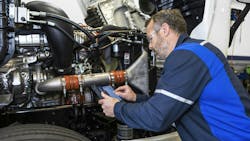For more on preventative maintenance and inspections:
The idea of preventative maintenance sound simple enough on paper, with fleets setting a schedule to check up on, replace, or repair certain vehicle systems to increase safety and meet regulations. But with many fleets handling preventative maintenance schedules in different ways based on their content and operations, it's possible for critical check-ups to slip through the cracks, which can lead to roadside violations and fines.
To avoid this, fleet managers need to be well-organized when approaching PMs. To help, here's some tips from various fleets and safety organizations on how to make sure no PM is missed and that they don't bog down daily operations.
How fleets schedule PMs
Because of the large fines and sheer complexity of fleet compliance, giving yourself some lead time might be the first consideration when planning when trucks are inspected.
“Most carriers schedule the next periodic/annual inspection for 11 months,” said Thomas Bray, sr. industry advisor at J. J. Keller & Associates. “That way, if the date is missed by a week or so, it is still getting done in the correct month.”
Chris Hough, VP of maintenance design and engineering for Penske Truck Leasing, also pointed out the importance of scheduling inspections and service in advance, and planning for enough time to complete follow-up repairs should any issues be discovered.
“Also, keep in mind that requirements may vary by equipment type, vehicle usage, and even geography,” he added.
Bray related that during standard periodic/annual inspections, items that turn up which are not always seen during routine maintenance include brake component issues with linings and hoses that are chafing or damaged, as well as small exhaust leaks in hard-to-spot areas, and windshield damage and obstructions.
“At carriers that do in-depth annual inspections, there are more items found due to additional inspection steps,” he said.
How different fleets prepare
With most of the equipment at Lily Transportation under a full-service lease, the carrier holds vendors accountable for meeting all maintenance requirements, including federal and state inspections and annual certifications, said Rusty Stevens, Lily VP of maintenance and fleet services.
Jerry Griener, VP of operations, procurement & fleet management at Transervice, noted that with a mix of full-service lease and contract maintenance agreements for their fleet, the emphasis is on following federal and state inspection requirements. “Additionally,” he said, “we need to make sure trucks are ready for the extreme temperatures that we can get in both winter and summer.”
At Greenbush Logistics, Matthew G. Kelly, director of maintenance, recommends four inspections per year. That includes a dry service at 20,000-mile and a wet service at 40,000-mile intervals. “Those are guidelines,” he said. “Each manufacturer is going to be different, and each technician will have learned a different way. The most important thing is that it was inspected thoroughly, referencing the recommended practices.”
At Blaine Brothers, a comprehensive approach is based on the belief that when it comes to preventive maintenance, going beyond the annual DOT inspection ensures customers’ equipment remains in peak condition, Trailer Service Manager Nick Richardson noted.
“A thorough inspection catches any potential issues before they become costly problems,” he said.
Blaine also schedules seasonal PMs to winterize trucks. “This includes checking and servicing the charging and electrical systems, inspecting the differential fluid, and addressing moisture in the air system by servicing the air dryer,” Richardson said. “We also check the block heater, test battery performance, and ensure coolant protection is sufficient.
“As spring rolls around, we shift our attention to services that prioritize cleaning the radiator and air cleaners, checking the air conditioning system, and making sure any upcoming DOT inspections are scheduled,” Richardson went on. “Trailer services during this period also include checking tarps and tarp covering systems, ensuring proper lubrication of moving parts, and inspecting trailer floors for wear or damage.”
For Dave Forgie, VP of maintenance at Leonard’s Express, performing annual PMs should be done not just to meet DOT requirements but also to strengthen general maintenance practices as well.
“We exceed recommended annual inspections,” he said. “We also perform DOT inspections at a PM interval, although our inspection covers more than just DOT items.
“For example, we do the same inspections at each 20,000-mile interval on trucks whether the oil is dropped or not,” Forgie continued. “We have found that a deeper inspection is a better option, even on a low mileage interval while drain intervals are being extended.”
At Leonard’s Express, trailer DOT inspections are completed every 90 days. “We never know where our trailers will end up across the country so we try to stay ahead of this each time we can,” Forgie related.
Inspection time estimates
Thomas Bray, sr. industry advisor at J. J. Keller & Associates noted that inspection time will depend on vehicle size and complexity and what is done, but included these estimates:
Periodic/annual inspection only:
- Small truck: 30 minutes up to 1 hour
- Large truck: 1 to 2 hours
Inspection plus other annual inspection/maintenance items:
- Small truck: Up to 4 hours
- Large truck: Up to 8 hours
How long should inspections take?
Inspection time requirements vary widely. Leonard’s Express, noted Forgie, plans for 2.5 hours on trucks and 1.5 hours on trailers. At NationaLease, according to Joe Puff, VP of truck technology & maintenance, a thorough general inspection takes about 2.5 to three hours. Hough reported that Penske inspections, combined with a PM, can be completed in around two hours, but you must also factor in the time required to complete follow-up repairs.
At Transervice, Griener related, the timing depends on the type of unit and any additional equipment, such as liftgates, reefers, and APUs. “We generally allot two to four hours for power units and one to two hours on trailers,” he said.
“For annual inspections, we allocate time based on the type of service to ensure thoroughness without unnecessary delays,” Richardson stated. “For DOT inspections, winterization, and basic service, we typically plan for 1 to 1.5 hours. For a more comprehensive and detailed service, we allow 3 to 3.5 hours.
“Trailer services, such as brake inspections, lighting checks, and suspension evaluations, are incorporated into these timelines, ensuring a holistic approach to maintaining both vehicles and trailers,” Richardson also said.
When issues are found during routine and annual inspections, service operations have implemented proven processes to ensure timely and effective repairs are made.
“If an issue is found on a truck, we immediately notify our driver advocates in dispatch,” Forgie said. “We attempt to give them the best estimated time to completion so they can plan around that.”
“The first method I’ve seen used is the technician is given the authority to immediately repair any defect covered in the standards,” Bray stated. “This practice is commonly used at carriers that are doing the periodic/annual inspection as a scheduled maintenance activity, and as a result expect to find defects. Another method some carriers use is to not even start the periodic/annual inspection until the vehicle has first gone through a PM type inspection.”
About the Author

Seth Skydel
Seth Skydel, a veteran industry editor, has more than 36 years of experience in fleet management, trucking, and transportation and logistics publications. Today, in editorial and marketing roles, he writes about fleet, service, and transportation management, vehicle and information technology, and industry trends and issues.

